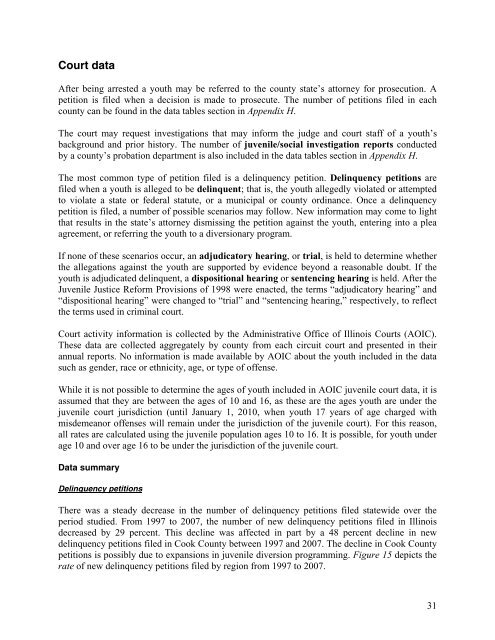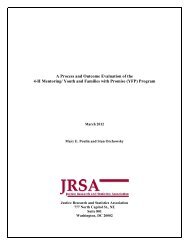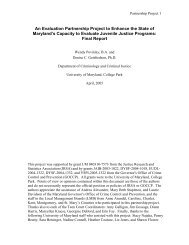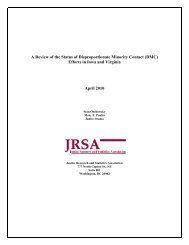Juvenile Justice System and Risk Factor Data - Illinois Criminal ...
Juvenile Justice System and Risk Factor Data - Illinois Criminal ...
Juvenile Justice System and Risk Factor Data - Illinois Criminal ...
Create successful ePaper yourself
Turn your PDF publications into a flip-book with our unique Google optimized e-Paper software.
Court data<br />
After being arrested a youth may be referred to the county state’s attorney for prosecution. A<br />
petition is filed when a decision is made to prosecute. The number of petitions filed in each<br />
county can be found in the data tables section in Appendix H.<br />
The court may request investigations that may inform the judge <strong>and</strong> court staff of a youth’s<br />
background <strong>and</strong> prior history. The number of juvenile/social investigation reports conducted<br />
by a county’s probation department is also included in the data tables section in Appendix H.<br />
The most common type of petition filed is a delinquency petition. Delinquency petitions are<br />
filed when a youth is alleged to be delinquent; that is, the youth allegedly violated or attempted<br />
to violate a state or federal statute, or a municipal or county ordinance. Once a delinquency<br />
petition is filed, a number of possible scenarios may follow. New information may come to light<br />
that results in the state’s attorney dismissing the petition against the youth, entering into a plea<br />
agreement, or referring the youth to a diversionary program.<br />
If none of these scenarios occur, an adjudicatory hearing, or trial, is held to determine whether<br />
the allegations against the youth are supported by evidence beyond a reasonable doubt. If the<br />
youth is adjudicated delinquent, a dispositional hearing or sentencing hearing is held. After the<br />
<strong>Juvenile</strong> <strong>Justice</strong> Reform Provisions of 1998 were enacted, the terms “adjudicatory hearing” <strong>and</strong><br />
“dispositional hearing” were changed to “trial” <strong>and</strong> “sentencing hearing,” respectively, to reflect<br />
the terms used in criminal court.<br />
Court activity information is collected by the Administrative Office of <strong>Illinois</strong> Courts (AOIC).<br />
These data are collected aggregately by county from each circuit court <strong>and</strong> presented in their<br />
annual reports. No information is made available by AOIC about the youth included in the data<br />
such as gender, race or ethnicity, age, or type of offense.<br />
While it is not possible to determine the ages of youth included in AOIC juvenile court data, it is<br />
assumed that they are between the ages of 10 <strong>and</strong> 16, as these are the ages youth are under the<br />
juvenile court jurisdiction (until January 1, 2010, when youth 17 years of age charged with<br />
misdemeanor offenses will remain under the jurisdiction of the juvenile court). For this reason,<br />
all rates are calculated using the juvenile population ages 10 to 16. It is possible, for youth under<br />
age 10 <strong>and</strong> over age 16 to be under the jurisdiction of the juvenile court.<br />
<strong>Data</strong> summary<br />
Delinquency petitions<br />
There was a steady decrease in the number of delinquency petitions filed statewide over the<br />
period studied. From 1997 to 2007, the number of new delinquency petitions filed in <strong>Illinois</strong><br />
decreased by 29 percent. This decline was affected in part by a 48 percent decline in new<br />
delinquency petitions filed in Cook County between 1997 <strong>and</strong> 2007. The decline in Cook County<br />
petitions is possibly due to expansions in juvenile<br />
diversion programming. Figure 15 depicts the<br />
rate of new delinquency petitions filed by region from 1997 to 2007.<br />
31

















